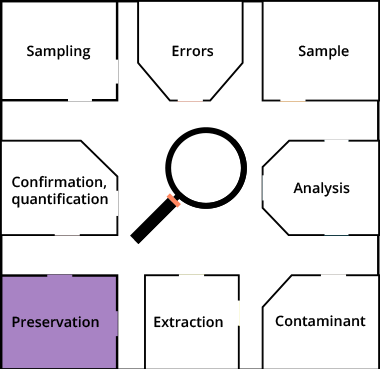Preservation
The preservation of the sample (from its collection to its arrival at the laboratory and its analysis) is an important step. If the sample is not stored in suitable conditions, this will lead to a significant error in the analytical results.
Three parameters must be properly adjusted and controlled during storage, as illustrated below.
TEMPERATURE?
The storage temperature must be precisely known and controlled. This temperature is often maintained at 4 to 6 °C (refrigerator storage) to limit reactions within the sample (especially biodegradation reactions). In some cases (especially long-term storage), a temperature of -20 °C (freezing) may be recommended.
LIGHT?
Some contaminants are light-sensitive (degraded by photolysis). It is therefore advisable to keep samples away from light to avoid degradation by photolysis.
DURATION?
It is preferable not to keep a sample for too long to avoid any possible change of composition. The length of time the sample can be stored without any deterioration depends very much on the temperature at which the sample is maintained. It also depends on the contaminant of interest and the nature of the sample.
In the absence of information on its stability over time during storage, it is advisable to analyze subsamples of the sample over time to monitor its stability during storage.


Your Investigation
Suggest storage conditions for the green coffee beans sampled.
Clue
The ochratoxin A molecule is stable, so it will not degrade, and there is no need to keep the sample away from light or analyze it quickly. However, green coffee beans must be kept dry and at a moderate temperature to avoid the formation of mould that could produce ochratoxin A during storage.






